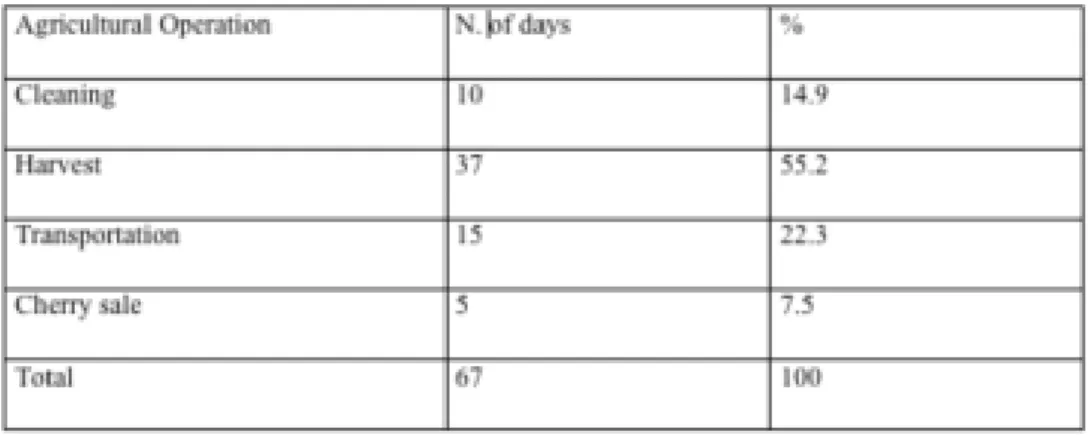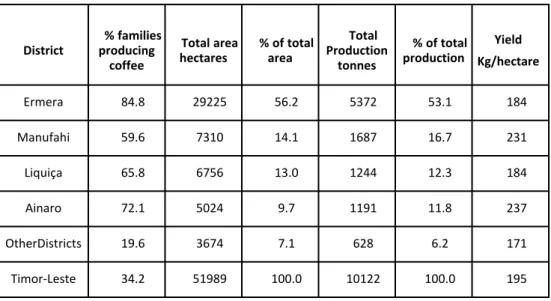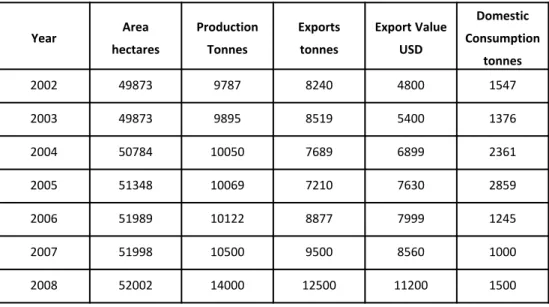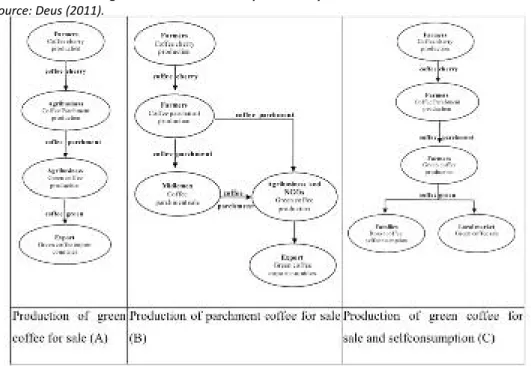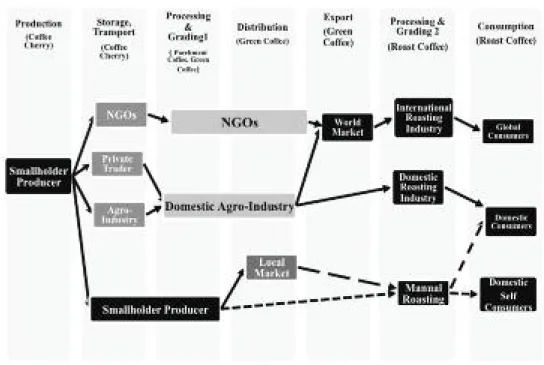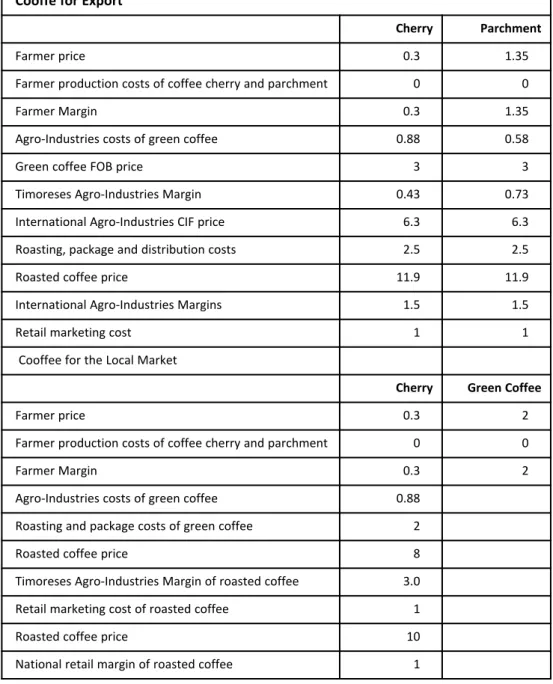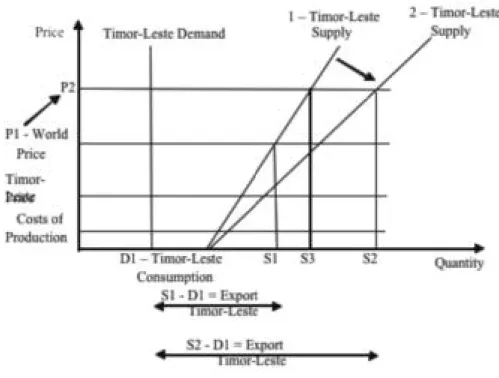C
OFFE VALUE CHAIN IN
T
IMOR
-L
ESTE
Pedro Damião Henriques.
Associated Professor CEFAGE - University of Évora, PortugalMaria Raquel Lucas.
Associated ProfessorCEFAGE - University of Évora, Portugal
Maria Leonor da Silva Carvalho.
Associated Professor ICAAM, CEFAGE - University of Évora, PortugalCarlos da Conceição de Deus.
Professor Universidade Nacional Timor Lorosa’e, Dili Timor-Leste“The arabica coffee producing countries have to Timor, and also to the technician who evaluated its merits and then studied and worked, a feeling debt of gratitude for the granting of the Hybrid of Timor, because from it were obtained cultivars with good yield potential and resistance to rust, that today form the basis of the world production of Arabica coffee” (Ferrão, 2002).
ABSTRACT
Coffee chains in Timor-Leste have many processes that go from producer to consumer, through suppliers and intermediaries in order to provide products, services and information with an increased value. The main phases of this chain have been analyzed through direct observation and interviews with key actors. The aim was to identify problems, examine the sales situation, discover opportunities, and weaknesses. There is room to increase yields and quality as well as the producers’ income through training of farmers, production and processing improvements and investmens in infrastructures. Furthermore, the improvement of market transparency is highly recommended and so is the adoption of complementary activities to improve the coffee value chain.
RESUMEN
En la cadena de valor del café de Timor Leste tienen lugar un conjunto de procesos desde el productor hasta el consumidor. a través de proveedores e intermediarios que proporcionan productos, servicios e información, y con ello un valor adicional. En este trabajo se caracterizaron las principales fases de esta cadena a partir de la observación directa y de encuestas a actores clave. El objetivo es poder identificar su problemática, sistema de venta, ventajas, inconvenientes, oportunidades y amenazas. Como resultados se plantea centrar el esfuerzo en determinados eslabones. Hay margen para aumentar la renta y la calidad, así como los ingresos del productor, mediante la capacitación de los agricultores, mejoras en la producción y procesamiento e inversiones en infraestructuras. Es muy recomendable la mejora en la transparencia de mercado y la adopción de actividades complementarias a la cadena de valor del café.
Palabras clave: cadena de valor, café, Timor Leste, competitividad
1. INTRODUCTION
Coffee production in Timor-Leste began during the Portuguese colonial period, nowadays being of fundamental importance for the economy and development of the country. Coffee growing remained one of the main cash crops during the Indonesian period and turned into a driving force for the development of rural areas in the post-independence period.
Coffee was introduced in Timor in the middle of the eighteenth century; first plantations were established in the early nineteenth century. But only by the mid-nineteenth century, coffee production started to develop, rapidly winning importance as source of income for farmers. Since then it has remained the islan’s main export product, becoming its real foreign currency.
Portuguese colonial governments encouraged the coffee cultivation through the establishment of plant nurseries and its distribution, requirement of coffee cultivation, construction of benefit plants, and the creation of support and experimental services. The crop structure was dominated by small farmers, holding less than 2 ha, while the large producers were quite small in number, but holding significant acreages. Domestic marketing and exports were dominated by Chinese and European intermediaries, often criticized for financially exploitiving local coffee producers.
In the beginning, the cultivated coffee type was the so-called tipica from Arabica species. By the end of the nineteenth century, however, with the emergence of the rust, the liberica species was introduced, followed by the robusta in the beginning of the twentieth century. The superior quality of the Arabica coffee produced in Timor, in terms of aroma, diversity of flavors and chemical composition, allowed an outstanding reputation in several markets and the benefit of a price premium since the mid-nineteenth century.
The best processing technology of coffee cherry in green coffee, the wet process, was already applied in the early twentieth century in the territory, encouraged by the several colonial governors because of its leading to a superior quality of the coffee. In addition, the coffee for export has a mechanical peeling, quality selection and classification.
After the occupation of the territory by Indonesia in 1975, coffee production continued to be the main income and exchange activity. However, there was little interest in maintaining or developing farming practices, or even in contributing to any return capital for coffee cultivation. The only interest was to extract income through the amount of coffee harvested and sold at a cheap price, mainly through the Indonesian port of Surabaya.
Coffee domestic market and exports were dominated by Indonesian companies through a monopolistic coffee regime. The companies charged reduced prices and their profits often helped to finance the occupation war. By the middle of the 90’s the monopoly was broken, with the emergence of the NCBA in the coffee processing and commercialization, giving place to a rise in coffee producer’s income.
Regarding the coffee industry during the Indonesian period, it can be said that its main legacy was the decreased interest in coffee cultivation among Timoreses, as farmers acted as plantation guardians, merely harvesting the coffee from the old large plantations as well as from their own small farms.
With the consolidation of the transition period and the restoration of the independence, the structure of production of coffee cherry remained, but other actors entered the market through purching of coffee directly from producers. Among these actors, the CCT (Cooperativa de café de Timor), Timor Global, Timorcorp, ELSAA Café, Always Café and NGOs (Non-Governmental Organizations) are noteworthy. Regarding the production, the Agriculture Ministry along with the NGOs and the international agencies for development aid have given support
to the reconversion of coffee plantations and to the improvement of the processing technology of coffee cherry to parchment.
Not accounting for oil products, coffee production continues having today a relevant role in the performance of the agricultral sector and in exports. It can be said that, since the mid-nineteenth century, the cultivation of coffee is the main product of the country´s economy, being its production in Timor-Leste much more a forestry than an orchard process (Silva, 1957). The forest nature of the Timor coffee is unsual because the plants are grown in the wild at the higher altitudes of a tropical island, and due to the lack of attention paid to the plantations, its production is natural, that is, organic by default.
There is consensus that the two main problems in coffee production are its low productivity and low quality. All coffee sector actors recognize that there is a great potential to produce high quality coffee and to gain on yield. In addition to these two problems, there is an unequal distribution of income generated by coffee between the different actors along the value chain. This inequality is not a post-independence problem, since it was introduced in the Portuguese colonial period and was also a mark of Indonesian occupation.
The aim of this chapter is to analyse the coffee sector in Timor-Leste, highlighting the aspects related to its value chain and competitiveness and comparative advantages of the sector. Data are based on secondary and primary sources, but where the experience and the knowledge of the territory were of great value and determinant for the developing work.
2. METHODOLOGY
The present study used the methodology applied in recent works of value chain studies of the food sector, both in the EU and the USA (Bijman, 2007; Briz et al., 2010; Briz et al., 2011) whose structure includes all the participating economic agents. In the case of Timor-Leste, the value chain of coffee is composed by farmers, intermediate traders, agro-industries, NGOs and consumers.
Data was obtained through primary and secondary sources. The secondary sources come from publications and official statistics of Timor-Leste, complemented by the invaluable experience and knowledge of the terrain of some of the authors. The primary sources were semi-structured qualitative interviews, direct observation and questionnaire surveys conducted with the most important
value chain economic agents. Moreover, content analysis of interviews, statistical analysis of questionnaires and SWOT analysis were performed. From the prior identification of weaknesses, threats, strengths and opportunities identified in previous studies, the SWOT has helped to achieve an operating overview of the current situation of the value chain of coffee from Timor-Leste and to identify possibilities for improvement.
Numerous difficulties were encountered in obtaining data, either due to scarcity and dispersion of information, lack of uniformity of the sources and nature of official data, obstacles in planning the interviews, ignorance of language and concepts used, or a lack of motivation of respondents to provide detailed information.
3. COFFEE PRODUCTION IN TIMOR-LESTE
There are two coffee species grown in Timor, Coffea arabica or simply arabica and Coffea canephora usually known as robusta. During the first half of the 20th century, the unlikely crossing of robusta (22 chromosomes and rust resistant) and
arabica (44 chromosomes and high quality coffee) led to the Timor hybrid. All
existing varieties of arabica rust resistant were obtained from this hybrid granted to the world in 1956.
Coffee is produced in all 13 districts of Timor-Leste, mostly by small households, but also in medium and big households, using the different altitudes of the territory. The coffee robusta is typically cultivated at a height of 600 and 1000 meters and the arabica at a height of 1000 to 2000 meters. Recent data from the Timor-Leste Agriculture Ministry show that the arabica is the dominant specie, occupying an area of 53.816 hectares, while the robusta occupies an area of 2.574 hectares. Relating to the green coffee yield, the coffee arabica represents about 79%, the robusta is 13% and the robusta and Arabica blend is 8% (Wahjudi, 2009). Regarding the quality aspect, it is superior for the arabica species which enables finest and exquisite coffees with an intense aroma, diversity of flavors and many variations in body and acidity. The robusta species has lower acidity, has less varied and refined flavors than arabica, but more soluble solids important for industrial use. Higher quality coffees use combinations of arabica and robusta.
The production technology of coffee can be divided into the following steps: production of the coffee cherry, production of coffee parchment, production of
green coffee and production of roasted coffee. Small farmers produce the coffee cherry and parchment which are sold to agri-businesses that produce and export green beans. The roasted coffee produced in Timor-Leste is only used for the local market.
3.1. Production technology of coffee cherry
In Timor-Leste, the production technology of the coffee cherry, beyond plantations, agricultural tools and gathering material, use little or almost no inputs. In general, farmers do not prune, clean the plantations, control pests and diseases, and substitute the old trees but only harvest the coffee of the existing plants. According to table 1, harvest dominates the labor use in coffee production, representing about 55.2% of the total labor.
Coffee production and yields are extremely low due to lack of management of plantations, in terms of pruning, fertilization, harvest quality and the substitution of old plants.
3.2. Coffee processing
Traditionally, in Timor-Leste, farmers process their own coffee cherry in coffee parchment. This can be done either through a dry or wet processing system. In the dry system, the cherry is picked and dried under the sun for ten days and then stored until it is peeled, or the cherry is picked, pulped, put into traditional baskets to ferment and then set to dry. This system leads to great quality variability because farmers use different techniques influencing the cherry maturity, fermentation, drying process and health conditions.
TABLE 1.- Labor use in coffee production.
The wet processing system, proposed by Esteves (1965) for Timor-Leste, nowadays handled by larger processing plants, begins with washing to sort the cherry by densitometry. Then, the cherry experiences a mechanic peel, fermentation in tanks, washing in channel with final sort by densitometry, and finally drying and sorting. For this technology, a peel machine, fermentation and washing tanks, as well as water availability are required. With this technique the quality of the coffee is improved.
The processing of coffee parchment in green coffee or green bean is also described by Esteves (1965). It is nowaday used by companies to process coffee parchment for export, including the steps of peeling, cleaning and the final sort of the coffee grain.
In 2002, about 75% of the coffee was produced using the dry method and the remaining 25% via the wet system, mainly by CCT (OXFAM, 2003) but as other agribusiness companies have settled down in the territory, the percentage of processed coffee using the wet system has been increasing. In order to process coffee parchment into green coffee, the majority of the agribusiness companies use mechanical equipment. In rural areas, the processing system used by farmers is pestle or mortar. The roasting of green coffee for supplying the internal market is done by small agribusiness, and in Díli the CCT unit needs to be emphasized. In rural areas the roasting takes place manually.
3.3. The socio-economic importance of coffee
Coffee has been the biggest source of income for mountain farmers and also the main export product of Timor-Leste, constituting more than 80% of export commodities.
In 2006, coffee plantations occupied an area of 51.989 hectares and producing 10.000 tons, in 2008, 14.000 tons. Production and area are concentrated in the districts of Emera, Manufahi, Liquiçá and Ainaro, representing about 92.9% of the total area and 93.8% of production (table 2). With exception of those districts, plus Aileu and Bobonaro, the production in the other districts is almost only for self-consumption and sale on local markets. The average yield is about 195 kg/hectare, Manufahi and Ainaro being the districts with the highest yield.
The average percentage of households growing coffee in Timor-Leste is about 34% (66.679 families). In the districts where coffee is widespread, namely, Ermera, Manufahi, Liquiça and Ainaro, the percentage is always higher than 60% (table 2).
The income obtained from coffee sales accounts for 90% of the household income, being an important resource to obtain food and other gooods needed throughout the year (OXFAM, 2003).
Considering the year 2006, and using data provided by the Direcção do Agronegócio (2008) fitted to an average yield of 195 kg/hectare of green coffee, the estimated gross margin is 338.1 USD per hectare. Considering an average area per household of 0.78 hectares, the annual average income per household from coffee production is about 264 USD which equals 0.72 USD a day. This value is lower than the defined poverty line for Timor-Leste which lies at 0.78 USD per day. Many coffee plantations are old and almost unproductive, with an estimated area of 28.960 hectares, representing about 56% of the total area of coffee production in 2006 (MAP, 2009). The conversion of these coffee plantations should be an agricultural policy priority. In 2006, the new planting of coffee trees consisted of about 1.350 hectares, 2.6% of the total area of coffee plantation. This new planting must be encouraged since its profitability, measured by Internal Rate of Return (IRR) is greater than 15% for the variety Arabica tipica and about 30% for the Timor hybrid (Henriques, 2010).
The coffee agribusiness employs a significant number of permanent and seasonal workers. The agribusiness sector linked to coffee is developing through the companies CCT, Timor Global, Timorcorp LTD, ELSAA café, Always café and others
District producing% families coffee
Total area
hectares % of totalarea
Total Production
tonnes
% of total
production Kg/hectareYield
Ermera 84.8 29225 56.2 5372 53.1 184 Manufahi 59.6 7310 14.1 1687 16.7 231 Liquiça 65.8 6756 13.0 1244 12.3 184 Ainaro 72.1 5024 9.7 1191 11.8 237 OtherDistricts 19.6 3674 7.1 628 6.2 171 Timor-Leste 34.2 51989 100.0 10122 100.0 195
TABLE 2.- Families, area, production and yield in 2006
that will eventually emerge. All these companies employ a significant number of workers, temporary and/or permanent.
Coffee is the main product of exportation in non-oil products. In 2001 it represented 75% of the total exports. In 2008, the coffee exports were around 11.2 million USD (table 3) and the share of coffee production on agricultural GDP is around 10%. Domestic consumption based on selfconsumption should be around 1000 tons per year.
In 2005, the main export destinations were USA (43.6%), Germany (29.4%), Indonesia (12.6%), Portugal (6.7%) and Australia ((3.4%) and export quotas were Timorcorp (27.1 %), Timor Global (24.4%), CCT (21.4%), ELSAA café (11.4%) and the remaining exporters (15.6%) (Direcção de Agronegócio, 2008; MAP, 2009).
4. COMMERCIALIZATION AND SUPLY CHAIN
Despite the country’s poverty, the coffee sector in Timor-Leste has been incresingly providing changes in producers’ standards of living (Moxham, 2001). The biggest changes were observed in commercialization, increasing substantially the number of buyers and exporters. At the same time, a considerable number of
Year Area hectares Production Tonnes Exports tonnes Export Value USD Domestic Consumption tonnes 2002 49873 9787 8240 4800 1547 2003 49873 9895 8519 5400 1376 2004 50784 10050 7689 6899 2361 2005 51348 10069 7210 7630 2859 2006 51989 10122 8877 7999 1245 2007 51998 10500 9500 8560 1000 2008 52002 14000 12500 11200 1500
TABLE 3.- Area, production, quantity exported, export value and domestic consumption of coffee
projects and sector initiatives appeared under responsibility of both, governmental and non-governmental organizations (NGOs).
4.1. Marketing channels
The main marketing channels for the coffee produced are presented in figure 1. The level of complexity depends on the number and function of each actor in the value chain. Coffee producer can go directly to the final consumer (figure 1 – channel C) or transfer that function to middlemen fulfilling several functions between the producer and the consumer (figure 1 – channels A and B).
The producer only produces cherry in channel A. This cherry is sold to the agribusiness between March and August (CCT, ELSAA cafés and Timor Global). They in turn assume the tasks of both processing cherry to parchment, and to green bean, and of exporting.
In channel B (figure 1) it can be observed that when the cherry is not sold to the agribusiness companies or when it is harvested after August, farmers assume both, the function of producer and the one of processor of cherry to parchment. Then it is sold to intermediate traders, to NGO’s, or to agribusiness companies – Always Café and Timorcorp LTD, that only process coffee parchment in green bean for exports.
FIGURE 1.- Marketing channels for the coffee produced by the farmers
Finally, channel C (figure 1) shows the steps of parchment that is not sold to intermediate traders, NGO’s, or agribusiness companies but being processed by farmers in green bean. The outcomes are consumed by the household or sold to local markets during the rain season in order to deal with the lack of income to buy food.
For example, in the case of CCT, the CCO (Organic Coffee Cooperative) purchased only Arabica coffee cherry from producers and carrried it to two factories and processing facilities located in Maubisse and Ermera. There it is transformed into parchment coffee and dried in the warehouses of CCT in Tibar. After that it is transformed into green bean in the factory located in Bidau and packaged in bags of 60 kg for export. As a leading coffee exporter, mantaining high coffee quality and getting good prices in international markets, the CCT keeps a porpotion of the profits for farmers, supporting health aspects, coffee plantation conversion and vocational training.
In the case of Timorcorp LTD, the company buys parchment coffee directly from individual farmers or midlemen located in the districts. These middlemen play the role of bringing together the production of parchment coffee prvodied by different small farmers. Timorcorp LTD does not purchase coffe cherry directly from farmers but from middleman and do their processing for parchment coffee. This coffee delivered to the factory in Dili, after evaluating the input it undergoes an additional drying when necessary, shelling, cleaning, grading and packaging in bags of 60 kg for export (Guterres, 2010).
The majority of coffee production from Timor-Leste is intended for foreign markets. As a result of being a small producer country and a world price taker, the price paid to local producers always reflects changes in global coffee markets.
As during the Portuguese colonial period and the Indonesian occupation, coffee export is concentrated on a small number of companies. The coffee cherry and parchment markets are oligopsony, being controlled by local producers, few companies and buyers. It seems there is no sort of regulation or clear and transparent information on prices received by export agri-industries. In this context, it is questionable whether the prices paid to producers are fair since the bargaining power of small producers is relatively small or non-existent.
4.2. Coffee value chain
The coffee chain in Timor-Leste has some special features compared to other value chains, both, with regard to its structure (business, organization, trade
barriers and trade channels) and conduct (size of contractual relations, trade margins, practices, competition, trader positions), as well as the nature and procedure (information flow, transparency, level of innovation) of the different stakeholders.
As can be seen in figure 2, the structure of the coffee value chain of Timor-Leste is short and simple. The major stages include the producer, the local buyer/middleman/collector or private trader, the processor and or exporter (producer, agro-industry or NGOs) and the consumer. Coffee producers are typically very poor uplanned subsistence farmers. Other value chain stakeholders include rural collectors, truck drivers or private traders handling small volumes and often acting as agents for processors’ cum exports. There are several groups of coffee buyers and exporters in Dili, including small development projects, NGOs, and traders mainly buying parchment and exporting through Indonesia, as well as heavily investing companies exporting directly from Dili, such as: Timor Corporation Ltd (took over the Delta Café firm in 2006) - its 2009 exports of green
FIGURE 2.- Timor-Leste Coffee Value Chain
bean amounted to about 4.700 mt, mostly sent to Germany and a few other countries; CCT - 2009 exports of green bean reached 1.500 mt, mostly sent to U.S.A. and Europe; ELSAA Café Ltd - export of green bean in 2009 was about 450 mt, mainly sent to Portugal; and Timor Global Ltd - with exports of 1.500 mt green bean in 2009. These four companies account for 90 percent of coffee exports. CCT has been leading the way by improving the processing quality and being the first to obtain Organic and Fair Trade Certification, experiencing a premium difference in f.o.b. price of approximately $0.10/kg green bean exported (World Bank, 2011).
Apart from these, there are a number of public institutions (Ministry of Agriculture) and local development organizations (bilateral cooperation agencies such as IPAD and NGO). Most cherry coffee farmers are families and use a rudimentary tecnhology. That means neither inputs nor suppliers are involved.
The secret to quality coffee lies mostly in its processing. Timor-Leste has excellent quality beans but these have to be processed within 24 hours of picking to prevent fermentation. Clean water and a clean drying surface are essential, too. Most coffee producers in the country do not have access to such conditions, prompting the suggestion that quality, and higher prices, should be promoted by building and equipping small processing plants to be used by a group of farmers within easy walking distance. Thus, the processing and distribution are higly concentrated, especially in agro-industries and the internal trade barriers are related to limitations on the change or evolution in value chain and relationship adjustments between actors. Some exceptions are the descendents of former producers who returned in 1999 and focus their activity inducing non-formal vertical or horizontal integration processes for economic reasons and export economies of scale.
The main difficulties of acess international markets, where Timor-Leste coffee has a great tradition and is well received, are related to maintaining a standard quality and the fundamental know-how to carry out export operations. These difficulties are due to the coffee production and processing technologies and to the isolation of the territory during the 24 years of Indonesian occupation. It could be overcome by creating a national certification agency for quality assurance, control and regulation and ensure market transparency. Presently each exporter is responsible for ensuring quality, with the result that inferior quality coffee sometimes finds its way to markets that demand higher quality, with potentially negative implications for the reputation of Timor-Leste coffee overall.
Relations between different value chain players, either at the horizontal level between members of the same rank, either vertical level between members of the same chain, or even diagonally, between members of other chains, are not formally constituted. In terms of ranking industrial organizations, CTT, ELSAA Cafés, Timor Global, TimorCorp and Always Café grouped processors and distributors. These include strengthening producers groups to improve harvesting practices, economies of scale in handling and transport, quality standardization, increasing international market bargaining power. The horizontal relationships are scarce despite the existence of CCO, an organic coffee cooperative that provides tecnhical assitance, information and other social services and is also its legal representative before the CCT, defending producers’ interests.
As regard to the behaviour of relationships between members of the coffee chain, contractual relations, trade margins and the fault or non-legal practices are to be referred.
The contractual structure that exists is fundamentally based on the market, with few formal agreements. The agents are the most important agro-industrial companies, wich usually orchestrated transactions with producers through intermediaries. The agreement between the producer and the agro-industry, which establishes a precise time, may require prior negotiation of price and its implementation for specific conditions or evolution, depending on the quality, the degree of maturation, the imputities and/or the size of coffee beans (cherry or parchment). Given the soil and the isolation of the territory, agro-industries are responsible for seeking farmers who buy coffee cherry or parchment, with the possibility of a long term relationship. The evolution of the producer on the value chain structure, incorporating up level competencies, is dependent on the time of the harvest, market access and the logic of the household on the need for generate income to meet their basic needs. Agro-industry plays only wholesale functions in export markets being the retail function for the importing companies.
As for non-compliance and/or illegal practices, are difficult to identify the extend that, in the field, written contracts are unsual and are not formally established standards or control systems and quality certification, traceability, labeling and packaging, among other aspects. However, each agro-industry has its control system influencing the price paid to producers and fixing trading margins. Consequently, there may be arbitrary practices that distort coffee quality and farmers’ income such as mixing lots of different qualities of coffee.
Timor-Leste coffee value chain operated as a result of its structure, behavior and type of actor. It can be evaluated by transparency, information, level of innovation and modernity. Because coffee available to consumers in international markets always result from blends of different varieties and origins, with different roasting technologies and private or distribution brands, this situation limits the transparency and visibility of the producer name or origin to consumer, although some information in the package, as occurs for example with Delta Cafés. The purpose of some agents of the chain is not always the one to provide high added value to the producer and consumer, but rather to meet individual goals, with the exception of the social functions performed by the CCT and some distribution companies who value the origin Timor coffee and the brand.
Information is another dimension of value chain whose distribution does not reach all the operators, in particular with regard to world prices, production technologies and processing and quality standards. In the first situation, the international market price is not transmitted accurately to different links of the value chain. For production and processing technologies, are known and have been published and performed by different actors, although the conversion of coffee is not being held at the desirable rate and processing technology is insufficient for producers of equipment failure and availability water. With regard to quality, standards and desirable quality assurance and quality management and traceability are well known but its application is limited by the absence of legal or technical reasons. From the global point of view, the transmission of information gaps due to the lack of an association that get the information to the different value chain participants. Also consumer trends do not come easily to the production, removing some producers, especially the latest, dynamism and adaptability.
Innovation and modernity are mainly focused on levels of processing and distribution, which will also concentrate on export. In these levels, agro-industries and NGOs seek to adjust processes and equipment for the improvement of Arabica coffee. At the production level, the conversion of old coffee trees and the reintroduction of cultural operations of pruning and cleaning will improve the quality of the coffee harvested, allowing the development of specialty coffees with organoleptic cleared.
In the exercise of estimating the margins in the value chain of coffee (Table 4),consider the prices received by different operators and related costs, including costs of production of coffee cherry farmers, the cost of processing coffee cherry,
coffee parchment and green coffee costs of marketing and distribution and roasting.
It is assumed that farmers do not buy inputs and labor use only family labor and natural resources. Thus, costs of production of coffee cherry, coffee parchment and green coffee farmers, variable costs are zero and fixed costs are negligible.Thus, revenue from the sale of coffee pays non-family labor.
The cost of processing coffee cherry in parchment and of this one in green coffee done by the agro-industries are reported in the literature (Direcção de Agronegócio, 2008 and Wahjudi, 2009), namely 0.30 and $ 0.58 per Kg. The costs of processing green coffee in roasted coffee by the import companies include transportation and shipping costs, roasted and packaging, estimated in $6.75per Kg. The costs of roasting the coffe sold in the local market are similar to the previous, excluding the shipping costs.
According to table 4, the farmers' gross margins for the three types of coffee sold are similar taking into account the conversion factors1. If the world price of coffee
cherry processed by wet system in the industries does not increase, the agro-industries margin agro-industry that buys parchment is greater than the margin of those which buy the coffee cherry. An important step toward improving quality standards overall would be the introduction of a national grading system. This is essential to establish and protect Timor-Leste’s name in the international coffee markets and to the increase the premium received by the Timorese coffee and thus add value to the chain. The increased margin is retained by agro-industries and also by international companies (e.g. CTT) that sell roasted coffee in the local market. If exporters can agree on a grading system, possibly with official support, and all exports have to be labeled accordingly, Timor-Leste can start establishing a reputation for quality and reliability.
Farmers’price could increase till $0.13 per Kg (42%) if they could have a share from the agro-industry margin. Generally, coffee farmers are paid a flat price for either cherry or parchment, and requirements demanded and the incentive paid to farmers for quality are weak. There are exceptions—for example, the recently introduced practices under the donor supported programs which assist smallholders in improving quality and negotiating with agroindustries. The coffee produced for export is sold as green beans, and the value-adding roasting process takes place in importing countries, where it is then blended and packaged into a consumer product. In those cases, farmers’price could increase till $1 per Kg (333%).
Cooffe for Export
Cherry Parchment
Farmer price 0.3 1.35
Farmer production costs of coffee cherry and parchment 0 0
Farmer Margin 0.3 1.35
Agro-Industries costs of green coffee 0.88 0.58
Green coffee FOB price 3 3
Timoreses Agro-Industries Margin 0.43 0.73
International Agro-Industries CIF price 6.3 6.3 Roasting, package and distribution costs 2.5 2.5
Roasted coffee price 11.9 11.9
International Agro-Industries Margins 1.5 1.5
Retail marketing cost 1 1
Cooffee for the Local Market
Cherry Green Coffee
Farmer price 0.3 2
Farmer production costs of coffee cherry and parchment 0 0
Farmer Margin 0.3 2
Agro-Industries costs of green coffee 0.88 Roasting and package costs of green coffee 2
Roasted coffee price 8
Timoreses Agro-Industries Margin of roasted coffee 3.0 Retail marketing cost of roasted coffee 1
Roasted coffee price 10
National retail margin of roasted coffee 1
TABLE 4.- Coffee Margins (USD per Kg)
5. COMPARATIVE ADVANTAGE AND COMPETITIVENESS OF
COFFEE
In terms of the world coffee market, Timor-Leste is a small country and therefore does not influence the world price. It exports coffe because has comparative advantage, the cost of production is lower than many other exporting and importing coutries.
Figure 3 explains the coffee market in Timor-Leste assuming that it is a small country and, consequently, a world price taker. It is also assumed that the demand for Timor-Leste (D) is relatively stable because the consumption already meets
people needs, the supply (S) is variable because there is potential to increase crop production, the production costs are low because the only relevant costs are labor costs, and the price of Timor-Leste is below the world price (P1) because a significant part of consumption is own production. Thus, for the world price P1, D1 is domestic consumption, production is S1 and exports are S1-D1.
The difficulties and potentialities of coffee production have been subject to reflections by several international and Timor-Leste experts. Table 5 summarizes those reflections and illustrates them into strengths, weaknesses, opportunities and threats.
FIGURE 3.- Timor-Leste comparative advantage
Human Resources
Farmers with low education and organization. Loss of agricultural practices during Indonesian time Farmers requalification and motivation. Establishment of coffee producers associations
Strengths Weaknesses Opportunities Threats
Coffee Production Firewood as a by product Protection for erosion Availability of land Old coffee plantations Unadequate agricultural practices Land ownership uncertainty
Organic Waste for fertilizer Wood for energy Replanting and land use planning Introduction of proper agricultural practices Land title certificates
Coffee diseases shade trees Diseases
TABLE 5.- Coffee strengths, weakness, opportunities and threats
Source: Adapted from Piggin (2003), Amaral (2003), Direcção de Agronegócio (2008) and Wahjudi (2009).
Processing and Markets
Organic Production Insufficient processing structures Low-Quality coffee International and regional markets Organic Trade Brand Quality Certification International competition Coffee world price variability World price decrease tendency Institutional Plan Insufficient Infrastructures Limited institutional Capacity Reduced financial resources for investment Insufficient interrelationship between actors in coffee development Dinamization of rural finantial markets Creation and promotion of soluble coffee industry and tourism (Coffee Museum) Creation of a regulatory body
Regarding human resources, the weaknesses are the low education levels and organization of farmers and the loss of the habit of doing agricultural practices during Indonesian occupation. These weaknesses reflect the existence of old and unproductive coffee plantations, the use of undequate agricultural practices and land ownership uncertainty. The strenghts correspond to the availability of land for new plantations, the collection of firewood for cooking as a byproduct and the role played by coffee trees in soil conservation and protection from erosion.
In processing and markets, the weaknesses are linked to insufficient processing structures and to the consequently low quality of coffee. Organic production is a strength. At the institutional level, weaknesses relate to the existance of inadequate basic infrastructures such as roads, transportations and telecomunications, limited public and private capacity as well as finantial resources for sector investments and insufficient interrelationship between different actors in coffee industry development.
To analyze the opportunities and threats, it is considered the development plan in action and the international environment. Coffee development plan has been promoted by the following institutions: Ministry of Agriculture and Forestry, Ministry of Tourism, Trade and Industry, Agency for International Cooperation (Missão Agrícola Portuguesa, USAID, ONGS, Peace Winds, PARC, OXFAM) and private sector through processing and export companies. The activities have contributed to an improvement and motivation of farmers, to the introduction of proper cultural practices, to the replacement of old coffee plantations and, to improvement quality through better processing and certification schemes. Since the coffee plant is permanent, the effects of some of these measures are not felt inmediatly but will bear in the future. The methodology used by some mentioned institutions to intervene among farmers is similar to that developed by the Timor-Leste Agricultural Services (Serviços Agrícolas de Timor) before 1975.
Greater attention should be paid to the establishment of coffee producer organizations, to secure regional and international markets, and to creating a quality certification agency and a coffee regulatory body. Special care should be taken on stimulation and promotion of coffee related industries, such as soluble coffee industries or tourism (Coffee Museum). In relation with the soluble coffee industry and considering the important Asian market, should be evaluated the possibility of creating a technological center for coffee based on international partnerships, that allow Timor-Leste to close its coffee industry cycle.
Regarding tourism, Pedro Sequeira (Timorese University Professor) advocates the creation of a coffee tourism route to be included on touristic activities of Timor-Leste visitors. This route would include the coffee museum whose location should be studied, though the old facilities of SAPT in Fato Bessi, should be considered given the heritage value of old facilities and the breathtaking scenery. Another key location on the coffee route is the born place of Timor-Leste hybrid in Mata Nova, Fato Bessi (Gonçalves et al., 1976a). The existing plants of the original Timor hybrid should be considered national heritage and studied the possibility of including the Timor-Leste traditional coffee plantation in the UNESCO heritage.
The improvement of infrastructure depends on the country general development plan. For coffee producing districts, this activity is the first to benefit and to create value from the improvement in country infrastructures by lowering transport and transaction costs.
The financial resources depend on the existence of land property rights to be used as finantial colateral to the institutions that provide capital for investment in coffee plantations. Issuing land property titles is a delicate matter because these titles have to be in accordance with traditional laws of property and land use rights. Domestic threats are coffee and shade trees diseases, which require urgent action to deal with coffee shading. At international level, foreign countries competition, world price variability and expected downwards price tendency are factors that can determine Timor-Leste export prices. Its history and tradition, brand-name and quality are the key-points that country can use in their international marketing strategy.
If the measures described above were taken, then: 1) the quality of coffee will increase inducing the world price for coffee in Timor-Leste from P1to P2; and 2) if there is a conversion of old and unproductive coffee plantations, Timor-Leste supply will increase from 1 to 2 (Figure 2). The combination of these two effects produces an increase in production from S1 to S2 and exports from S1-D1to S2-D1. It is expected that farmers’ incomes will rise due to increased production and prices. The additional price for quality should be not only for exporters but also should reach farmers. Wahjudi (2009) proposes the creation of an export tax to redistribute income by farmers. In the Portuguese colonial period, this rate existed and served to give incentives to coffee producers through technical support and coffee plantations replanting or rehabilitation.
The first effect, increasing in quality, can happen in the short term but the seconf one, increasing in production, will only happen in the long run because the conversion of plantations takes between 3 to 5 years. Hence, if the best practices for harvesting and processing are implemented by farmers, it is expected in the short run an increase in production to S3and in exports to S3-D1.
In summary, increasing the quality and production will expand: employment and labour in rural areas, exports, country inflow revenue, income of coffee farmers and their families and, the welfare of Timor-Leste rural populations. Nogueira (2009) estimates an increase of about 600 USD per year in the family income if the parchment production increased from 200 to 600 kg.
In addition to providing an increase in installed agribusiness capacity that process and export coffee, increases in production will permit the entrance of new agribusiness in the market and, consequently, investments and employment enlarge and competition improves. In coffee-producing districts, coffee activity can and should be used as key element for local and regional development plans.
FIGURE 4.- Effect of increased quality and production in the exports
6. CONCLUSIONS AND FINAL REMARKS
The arabica coffee production plays a key role in income and well-being of the rural population of coffee districts of Timor-Leste since the late nineteenth century.
Despite the historical and political evolution, the structure of production, processing and internal and external marketing of coffee has not changed significantly over time. Production continues to be dominated by small local producers, the coffee plantations are still old, processing and foreign trade continues to be made by a few agro-industrial companies and intermediaries, and market transparency at different levels of marketing channels continues to be insufficient.
Since most of the production is destined to foreign markets, dominant marketing channels are those where producers produce cherry and parchment coffee for sale to the agro-industrial companies and intermediaries.
From the analysis of coffee value chain one can be conclude, as in the past, that the higher margins generated by this activity are appropriated by agro-industrial domestic and foreign companies. This raises the question of the existence of a fair and equitable redistribution of the margins, originated in this activity, in the nodes of the value chain, especially for small local producers. This inequality redistribution is a historical question, reported in the beginning of twentieth century, taken up by Gonçalves (1975) in the seventies, raised by Guterres (2010) and Deus (2011) and verified in this work.
A more equitable redistribution of margins should be induced, not only by greater transparency of prices charged to the foreign market, so that the export price should be reflected in the local producer market for coffee cherries and parchment, but should also through the conversion of old coffee plantations and the use of more appropriate farming techniques, improved infrastructure and access to markets, and by careful application of quality standards for production and processing in order to regain the fame and the price premium that Timor coffee have had international markets
DISCUSSION QUESTIONS
a) Results indicated quality of coffee processed by farmers and coffee plantation regeneration as the two major areas for policy action. Which areas could be considered as potentially useful and viable and which other areas could be considered for policy actions, including marketing and logistics in order to increase farmers’ income?
b) At the current stage much value is being lost due to inappropriate processing of coffee cherry by farmers who do not have access to processing facilities or do not have the technical knowledge. Considering the resource constraints of the Timorese coffee sector, discuss the facilities that would allow farmers to properly process coffee cherry ensuring greater competition and could help farmers to offer for sale a better quality of the product at a better price. c) Price stability, which is not a simple and direct solution, is one of the main
problems in the Timorese coffee sector. More direct intermediation measures suggest increasing efforts to broadcast daily price information during the coffee season, establishing an indicative price floor, reestablishing the old coffee markets or, obtain fair trade prices (typically higher than world prices), envolving NGOs in order to provide technical assistance and direct access to fair trade outlets abroad. Discuss all these measures.
d) With current quality and grading levels and packaging technologies, argue the viability of integrating the value chain and performing more value adding stages of the processing cycle in Timor-Leste, including roasting and packaging, and try to produce in Timor-Leste a premium roasted coffee directed at niche markets. e) An important step toward improving quality standards overall would be the introduction of a national grading system. Why is it essential to establish and protect Timor-Leste’s name with a brand name in the international coffee markets?
NOTES
1. Conversion coefficients: coffee cherry to parchment coffee = 0,22; to parchment coffee to green coffee = 0,8; green coffee to roast coffee=0,8.
REFERENCES
Amaral, F. E. (2003). Prospects for coffee development in Timor-Leste, in
Agriculture: New Directions for a New Nation, edited by Hélder da Costa,
Colin Piggin, César da Cruz and James Fox, ACIAR, Proceedings N. 113. Bijman, J., (2007). The role of producer organizations in consumer-oriented
agrifood chains: an economic organization perspective”. Tropical Food
Chains, Governance Regimes for Quality Management. R. Ruben, M. von
Boekel, A. van Tilburg; J. Trienekens (Eds). Wageningen Academic Publishers 257-279.
Briz, J., de Felipe, I., Briz, T. (2010). La cadena de valor alimentaría. Un enfoque metodológico”.Boletín Económicode ICE, 2983. 45-55.
Briz, J., de Felipe, I., Asunción, I. (2011). Cadena de valor corta: caso cadena hortofrutícola Aranjuez-Madrid”. La cadena de valor agroalimentaría:
análisis internacional de casos reales. Briz, J. (Ed.). Editoral Agricola 401-426.
Deus, C. C. (2010). Impacto do desempenho da CCT na satisfação e qualidade de
vida dos seus membros. Dissertação de Mestrado em Gestão - Recursos
Humanos, Universidade de Évora.
Direcção de Agronegócio (2008). Commodity Profile for Coffee. Ministério da Agricultura e Pescas, Díli, Timor Leste.
Direcção Nacional Plantas Industriais e Agrocomércio (2009). Evolução das Culturas
Agrícolas. Ministério da Agricultura e Pescas, Díli, Timor Leste.
Esteves, A. B. (1965). Preparo de Cafés em Timor, MEAU, Re-edited by TimorAgri. Ferrao, J. E. M. (2002). Os cafeeiros em Timor, Oriente, n.º 3, p. 31-40.
Goncalves, M. M., Mexia, J. N. (1975). Evolução da Exportação de Café em 1947/74
e sua Previsão para 1975/77, MEAU, Re-edited by TimorAgri.
Goncalves, M. M., Rodrigues, M. L. (1976ª): Nota Sobre as Possibilidades de
Produção do “ Híbrido de Timor “ no Seu Habitante Natural, Lisboa, MEAU,
Guterres, V. C. (2010): Comercialização interna e externa de café na empresa de
Timorcorp, em Comoro-Timor-Leste. Relatório final do estágio em Ciências
Agrárias.
Henriques, P. D. S. (2010). A Rendibilidade da cultura do café. Documento de trabalho, Díli.
Ministério da Agricultura e Florestas (MAF). (2009). Estatísticas agrícolas, Direcção de Culturas Industriais e Agronegócio, Díli.
Moxham, B. (2001). Grinding poverty? Coffee and the development challenges for
Timor-Leste, University of Melbourne.
Nogueria, M. (2009). Gestão das Plantações. 1ª Conferência Internacional Café Timor, Díli, Timor Leste.
OXFAM (2003). Overview of the Coffee Sector in Timor Leste. edited by TimorAgri. Piggin, C. (2003). Working Group SWOT analysis on agricultural development in
Timor-Leste. edited by Hélder da Costa, Colin Piggin, César da Cruz e James
Fox, ACIAR Proceedings Nº 113.
Silva, H. L. (1956). Timor e a Cultura do Café, Memórias – Série de Agronomia Tropical, Junta de Investigações do Ultramar, Ministério do Ultramar, Re-edited by TimorAgri.
Wahjudi, B. (2009). A Economia do Café de Timor Leste. Gabinete do Ministro do Turismo, Comércio e Indústria, Díli.
World Bank. (2011): Expanding Timor-Leste’s Near-Term Agricultural Exports, vol I- Main report, Diagnostic Trade Integration Study (DTIS), January.
